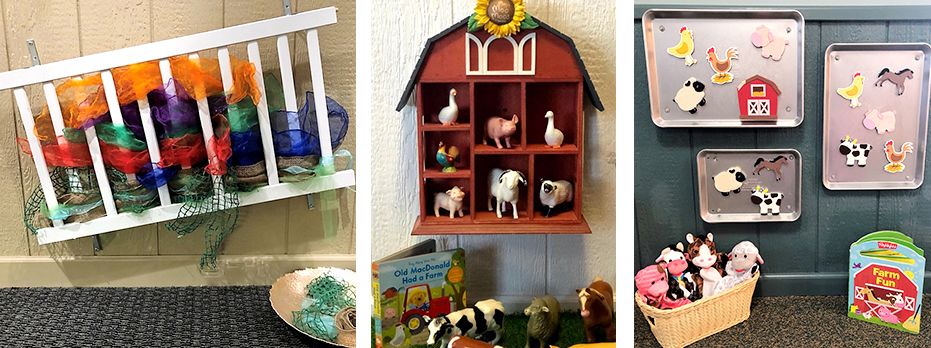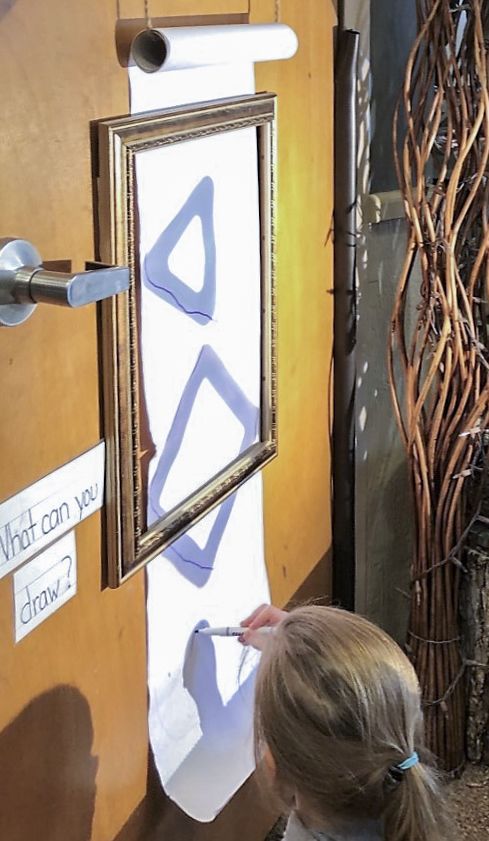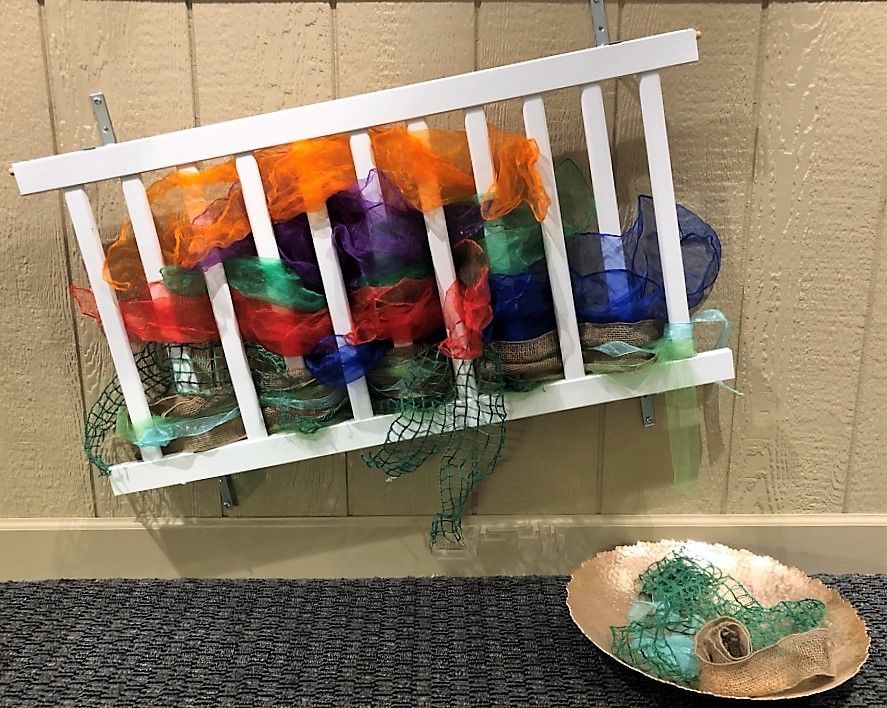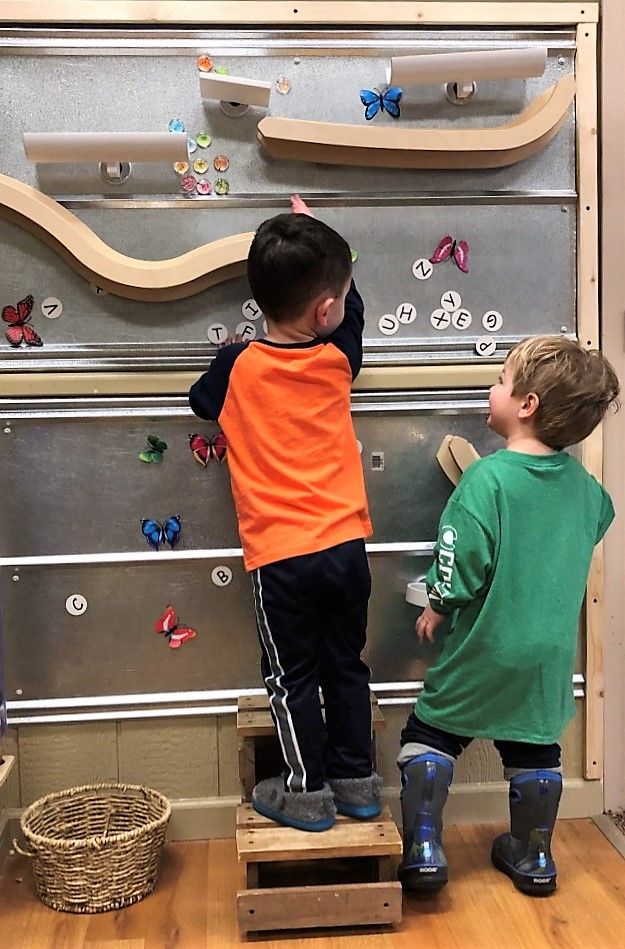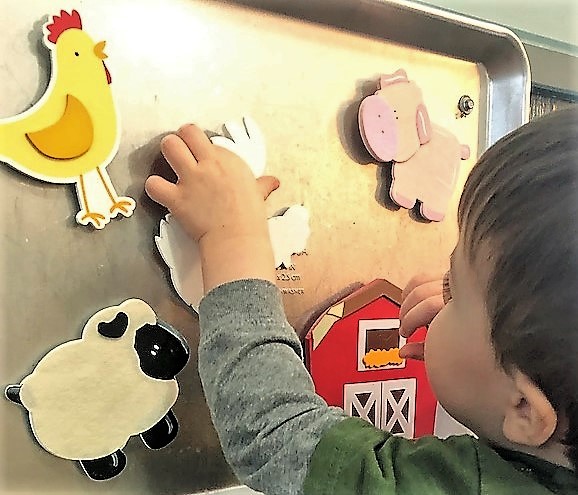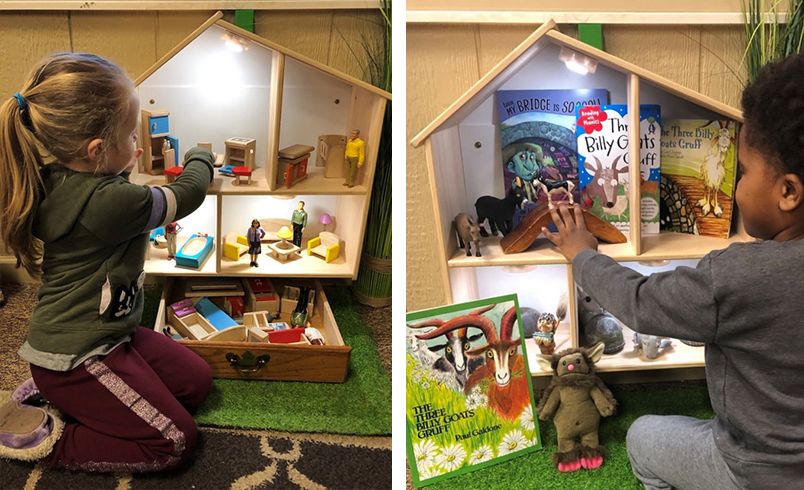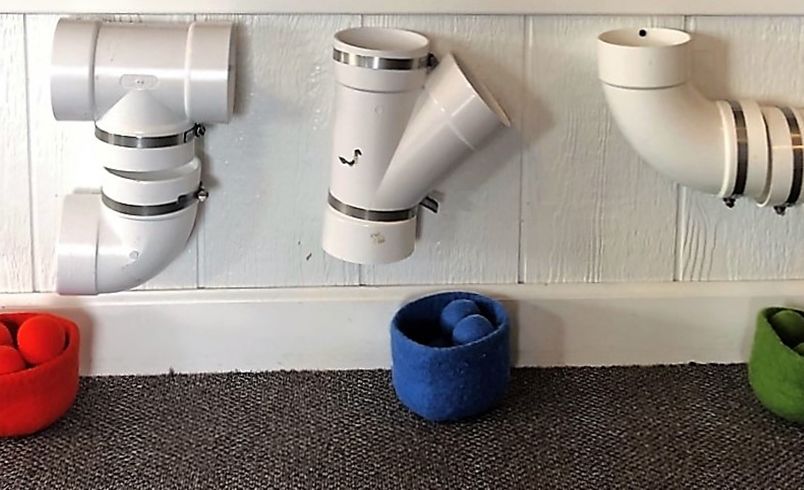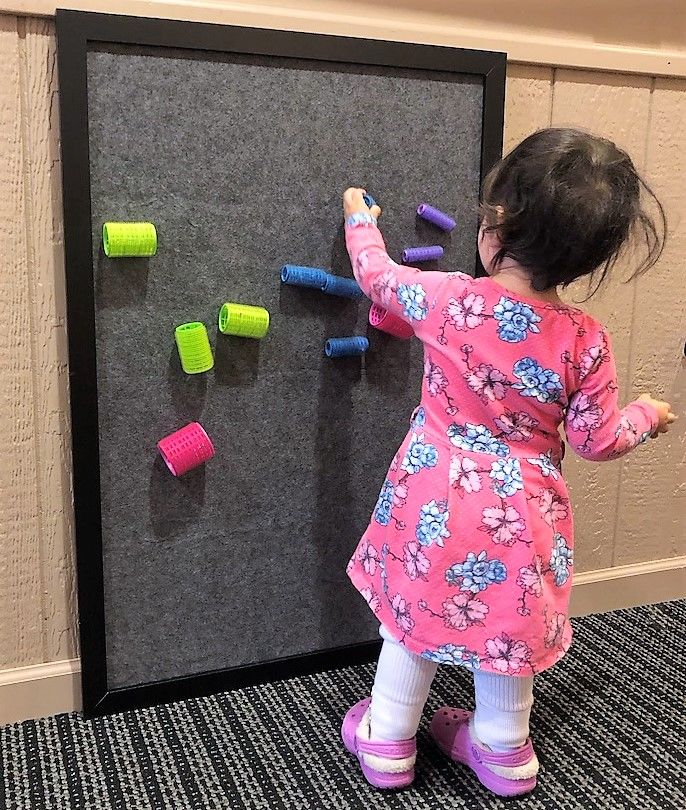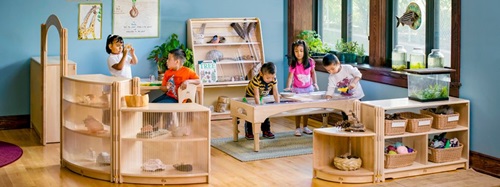Vertical Learning with Classroom Walls
| April 2019When conjuring up the image of a traditional elementary school classroom, most will visualize tables and desks, a teacher’s desk, wall clock, pencil sharpener—and of course—a blackboard complete with chalk and erasers. Blackboards, because of their simplicity, are considered one of the most revolutionary educational tools ever invented.
Despite its popularity in elementary schools, blackboards are scarcely seen in early childhood classrooms. With the concentration of children’s activities being on horizontal surfaces, the vertical surfaces of classroom walls are often overlooked as places for active engagement. Instead, this valuable wall space is primarily reserved for adult decoration, posting mandatory information, or possibly displaying children’s artwork.
This is an invitation to view your classroom walls as a powerful tool for learning; to understand that walls are more than flat one-dimensional surfaces upon which to display children’s work or hang commercially-made posters, laminated charts, and learning materials. This is an invitation to begin thinking about your classroom walls as valuable real estate (i.e., square footage), which is just as important in children’s growth and development as the equipment and materials located on your floor space. Begin by critically thinking about the purpose of your classroom walls and ask these questions:
- What is currently posted on the walls and why?
- What is the purpose of the material I am posting?
- Do the posted materials honor children’s work and the work of the classroom?
- Do the walls have meaningful connections to children’s interests?
The most important question, however, is: Are most of the posted materials active or passive? In their book, Through a Child’s Eyes: How Classroom Design Inspires Learning and Wonder, Dr. Sandra Duncan, Jody Martin, and Sally Haughey encourage teachers to transform passive wall materials into interactive places for young children. Rather than thinking about classroom walls solely as a place to post “stuff”, start viewing walls as places for children to actively interact and engage. Begin using the classroom walls as a powerful learning tool and capture their power by creating vertical learning environments that offer children places to play, collaborate, manipulate, and learn.
A vertical learning environment is any vertical surface covered with two- and three-dimensional objects that afford children opportunities for perception, manipulation, interaction, construction of knowledge, and representation Readdick & Bartlett (1994), p. 86.
Vertical learning environments can be designed for all age groups—even infants. Their versatility in design means that some are created in a matter of minutes while others take more time. Many vertical learning environments require materials that are easy-to-obtain while others need more finances, additional human resources, or may require a trip to the local hardware or home improvement store. They are made from a wealth of materials such as wood, PVC piping, metal roofing, fabric, magnetic board, carpet pieces, or curtain rods. Here are a few tips and ideas for designing effective vertical learning environments:
- Mount apparatus at appropriate height and within children’s reach. A rule of thumb is to place vertical environments at the child’s eye level. To accommodate two children playing side-by-side, a width of at least 40" is recommended for infants, toddlers, and twos; 50" for preschoolers; and, 60" is recommended for young school age (Readdick & Bartlett, 1994)
- Use authentic and natural items for the construction of vertical learning spaces, shy away from objects made from plastic
- Construct durable surfaces and install sturdy objects suitable for heavy-duty manipulation and many children’s hands
- Install vertical learning environments so they are not positioned in or near major traffic pathways or classroom doors
- Keep safety in mind when choosing parts and objects for the vertical learning environment, and select materials appropriate for the children’s age and skill level
As early childhood educators, we know the importance of providing active and hands-on learning experiences for young children. The majority of these hands-on experiences are planned for, and occur, on horizontal surfaces such as tables and floors. Why not expand children’s opportunities for engagement by using the vertical space (i.e., walls) in the classroom? Here are four reasons why it is important to include vertical environments not only in our classroom design, but in our pedagogy and approaches to learning.
1. Encourages Midline Crossing. If you were to draw a line down the middle of your body, and reach your right arm over this line to touch your left elbow, you have crossed your midline. Crossing the body’s midline helps both sides of the brain to communicate and is an important component of successful development. Crossing the midline is also a precursor for learning to read, which requires the ability to move one’s eyes from left to right across the page. Research has found that children who have difficulty in crossing their body’s midline may experience decreased coordination, face challenges in higher level thinking, or struggle learning how to read. Providing opportunities for cross body movements on the classroom’s vertical surfaces is a brilliant way to help both sides of brain communicate and map properly for successful growth and development.
2. Increases Spatial Awareness. Working on vertical learning surfaces helps children develop spatial awareness and learn basic concepts such as left, right; up, down; and high and low. Spatial concepts such as sense of distance are learned when manipulating objects on vertical surface because the working surface is at the child’s eye level. In other words, the child looks directly at the surface rather than looking down on the surface (i.e., table top or floor). Pediatric physical therapist Lauren Drobnjak (2013) believes spatial concepts experienced on a vertical surface are “much easier to understand because the child can relate the words to his very own body” (p. 1). Offering hands-on experiences and active engagement on a vertical surface is an effective strategy for helping young children gain body awareness and an understanding of spatial relationships.
3. Improves Proprioception. Proprioception is the child’s unconscious perception of movement through space as well as the orientation of one’s body in space. Therapists believe that proprioception can be improved through sensory integration experiences. These experiences can be as easy as lifting the arms over the head, giving bear hugs, and jumping up and down. Or, proprioceptive experiences can be heavy work activities that wakeup children’s muscles and put their bodies in an alert state such as pushing a heavy log on the playground or stacking chairs in the classroom. Working on a vertical surface increases both movement and resistance (heavy work), providing a great proprioceptive experience.
4. Promotes Affordance. Psychologist James Jerome Gibson believed that visual cues in the environment suggest possibilities for one’s actions. According to Gibson, there are environmental cues that invite or make offers for a person to take action upon its objects. A door handle, for example, sends an invitation of pulling, pushing, or sliding. Gibson coined these action cues or perceptions of the environment as “affordances”. In the early childhood classroom, Gibson’s theory of affordance aligns with vertical learning environments because they send a message of invitation for children to take action and explore the possibilities of its objects.
Creating vertical wall environments is fun and exciting. Use the following ideas to spark your own potential in transforming discarded home furnishings, damaged furniture, or inexpensive building materials into wonderful and authentic vertical learning walls.
#1: Metal Wall
Metal magnet-type walls are perfect for both the older age group and for the very young. Metal makes a durable and sturdy element for wall environments and can withstand children’s inevitable bumping and banging. Look at the body language of the two boys deeply engaged in conversation. Just imagine the concentrated thinking that is happening between them about how to manipulate objects on the metal wall.
This wall was made from a piece of metal roofing, which was purchased at the local home improvement store. Metal roofing pieces come in 8' sections and are easily cut to the needed size of the vertical learning environment with tin snips (Be careful of the sharp edges when cutting the roofing material.). The metal piece was attached to the wall using heavy-duty screws, the sides of the metal were trimmed out with a 1”x 1” furring strip (or wood trim), and then screwed through the metal piece onto the wall. It is very important to trim out the metal piece with furring strips to cover its sharp edges. Furring strips can be purchased inexpensively from a home improvement store.
Note: A low step stool was added to the area to encourage children to take risks and reach to the very top. The stool was made from a pallet and has two steps to allow multiple heights. The basket is used to catch the balls that children use on the ramps.
#2: Baking Pan Wall
The very young child has an essential urge to attach and detach, which is just what this vertical learning promotes.
To create this engaging vertical learning environment, the teacher used baking or cookie sheets purchased at a Dollar Store and attached them with metal screws and a battery powered drill. After hanging the metal cookie sheets, the teacher found some stray puzzle parts, attached a strip of magnetic tape to the back of the puzzle piece, and added to the vertical learning space. These pieces are perfect for little fingers to grab and practice their pincer grip as they manipulate the farm animals.
#3: Wall Worlds
Young children adore working with small stuff—perhaps it is because they are so small and find themselves living in a giant-sized adult world. So why not create small worlds on the classroom wall? Manipulating a small world such as the objects in the preschool dollhouse gives unlimited power to arrange, ability to make decisions, and freedom to change, rearrange, redesign, and change—over and over and over again. And this idea does not have to be limited to preschool age and is quickly changed to reflect the children’s interests and ideas.
The dollhouse and barn were mounted to the wall using a battery-powered drill and wood screws. Note the drawer under the preschool dollhouse. This drawer was taken from a recycled end table and makes a perfect container for all the dollhouse’s furniture and people. Add a book to the small world to inspire children’s vocabulary and language development.
#4: Pipes & Tubes Wall
A vertical learning environment made from large PVC pipes is a perfect playing and learning experience for babies and toddlers. The repetitive action of putting the balls into the top of the pipe and watching them come out the bottom promotes knowledge of cause and effect, as well as spatial relationships and proprioception. Undoubtedly, it’s hard physical and cognitive work for a toddler to pick up a ball, balance it in her hands, skillfully plop it down the PVC’s opening, and finally come to understand where the ball will once again appear. Babies’ core muscles grow strong as they pick up and put the balls in the tubes over and over again. As they bend over, stand up, and bend over again . . . and again, they practice balance and increase the stability of their bodies. Installing a PVC pipe vertical environment is simple. The hardest part is driving to the home improvement store and purchasing 4" PVC pipes, metal hose clamps, and screws. Once that is accomplished, simply find the perfect spot for the environment and attach the pipes to the wall with the metal hose clamps. All you need is a battery powered drill to finish off the job.
#5: Curler Wall
It is important for early childhood educators to acknowledge and understand that children are born into the world with an inherent initiative to be self-learners through exploration and movement. In her book, Your Self-Confident Baby: How to Encourage Your Child’s Natural Abilities, Dr. Magda Gerber recommends that—as a matter of principle—educators and parents should refrain from teaching skills through forced repetition and formalized practice. Rather, in order to fulfill children’s inborn need to learn through exploration, we must provide environments designed for physical movement.
Curlers aren’t just for creating a fabulous hairdo. They can also be used to make a vertical learning environment designed for articulating young children’s hands, fingers, and wrists.
A Final—but very important—Advantage of Vertical Learning Environments
Teachers often struggle with the size or square footage of their classrooms making space a highly valued premium. Because their classrooms are not grandiose, even fitting in the required learning centers (i.e., blocks, writing, art, home living) is challenging. Quite simply, there is not enough floor space to accommodate all the furniture, equipment, toys, and learning materials, Vertical learning environments are the perfect solution to this problem. Who needs floor space when you have wall space? So, the next time you are looking for extra classroom space, try using your classroom walls.
And, by the way, don’t forget the iconic blackboard! It’s as simple as buying a jar of chalkboard paint from the local hardware store.
References
Drobnjak, Lauren (2013). Why kids should work on a vertical surface. https://theinspiredtreehouse.com/?s=vertical. Retrieved February 15, 2019.
Duncan, Sandra, Jody Martin, & Sally Haughey (TBP, 2019). Through a Child’s Eyes: How Classroom Design Inspires Learning and Wonder. Lewisville, NC: Gryphon House.
Gerber, Magda & Allison Johnson (1998). Your Self-Confident Baby: How to Encourage Your Child’s Natural Abilities. New York, NY: John Wiley & Sons.
Gibson, James J. & Leonard Carmichael (1950). The Perception of the Visual World. New York NY: Houghton Mifflin.
Lewis, Barbara (1978). Sensory Deprivation in Young Children. Child: Care, Health, and Development. 4(4), 229-238.
Readdick, Christine & Patricia Bartlett. (1994). Vertical Learning Environments. Journal of Childhood Education, 70(2), 86-90.

